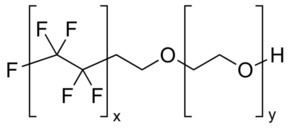 | ||
Global and china fluorosurfactants surfactants industry research report and 2009 2019 forecast
Fluorosurfactants, (also fluorinated surfactants, perfluorinated alkylated substances or PFASs are synthetic organofluorine chemical compounds that have multiple fluorine atoms. They can be polyfluorinated or fluorocarbon-based (perfluorinated). As surfactants, they are more effective at lowering the surface tension of water than comparable hydrocarbon surfactants. They have a fluorinated "tail" and a hydrophilic "head." Some human-made fluorosurfactants, such as PFOS and PFOA, are persistent organic pollutants and are detected in humans and wildlife.
Contents
- Global and china fluorosurfactants surfactants industry research report and 2009 2019 forecast
- Global and chinese fluorosurfactants industry 2015 2020 prof research group
- Physical and chemical properties
- Economic role
- Health and environmental concerns
- Examples
- References
Global and chinese fluorosurfactants industry 2015 2020 prof research group
Physical and chemical properties
Fluorosurfactants can lower the surface tension of water down to a value half of what is attainable by using hydrocarbon surfactants. This ability is due to the lipophobic nature of fluorocarbons, as fluorosurfactants tend to concentrate at the liquid-air interface. They are not as susceptible to the London dispersion force, a factor contributing to lipophilicity, because the electronegativity of fluorine reduces the polarizability of the surfactants' fluorinated molecular surface. Therefore, the attractive interactions resulting from the "fleeting dipoles" are reduced, in comparison to hydrocarbon surfactants. Fluorosurfactants are more stable and fit for harsh conditions than hydrocarbon surfactants because of the stability of the carbon–fluorine bond. Likewise, perfluorinated surfactants persist in the environment for that reason.
Economic role
Fluorosurfactants play a key economic role for companies such as DuPont, 3M, and W. L. Gore & Associates because they are used in emulsion polymerization to produce fluoropolymers. Fluorosurfactants have two main markets: a $1 billion annual market for use in stain repellents, and a $100 million annual market for use in polishes, paints, and coatings.
Health and environmental concerns
Fluorosurfactants such as perfluorooctanesulfonic acid (PFOS), perfluorooctanoic acid (PFOA), and perfluorononanoic acid (PFNA) have caught the attention of regulatory agencies because of their persistence, toxicity, and widespread occurrence in the blood of general populations and wildlife. In 2009 PFASs were listed as persistent organic pollutants under the Stockholm Convention, due to their ubiquitous, persistent, bioaccumulative, and toxic nature. Their production has been regulated or phased out by manufacturers, such as 3M, DuPont, Daikin, and Miteni in the USA, Japan, and Europe.
However, some manufacturers have now replaced PTFOS and PFOA with short-chain PFASs, such as perfluorohexanoic acid (PFHxA), perfluorobutanesulfonic acid and perfluorobutane sulfonate (PFBS). Studies do indicate that shorter fluorosurfactants are less prone to accumulating in the human body; however there is still concern that they may be harmful to both humans, are and the environment at large.
